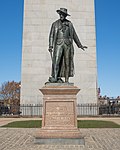St. Mary – St. Catherine of Siena Parish

St. Mary – St. Catherine of Siena is an historic Roman Catholic parish in Charlestown, Massachusetts. It resulted from the 2006 merger of two older parishes, St. Catherine of Siena on Vine St. and St. Mary's on Warren and Winthrop. The parish occupies the latter's building, which was one of the later masterpieces of Patrick Keely. Built between 1887 and 1893, its ornate interior boasts stained glass windows by Franz Mayer & Co. and a hammer-beam oak ceiling with angels, carved by Keely himself. The St. Catherine's building, a Romanesque design completed in 1895, was closed in 2008. Visually the brick building is a well-known landmark visible from the Tobin Bridge. Four of the stained glass windows from the shuttered church were installed in the Seaport Shrine.
Excerpt from the Wikipedia article St. Mary – St. Catherine of Siena Parish (License: CC BY-SA 3.0, Authors, Images).St. Mary – St. Catherine of Siena Parish
Warren Street, Boston Charlestown
Geographical coordinates (GPS) Address Nearby Places Show on map
Geographical coordinates (GPS)
| Latitude | Longitude |
|---|---|
| N 42.373672222222 ° | E -71.06165 ° |
Address
Warren Street 44
02129 Boston, Charlestown
Massachusetts, United States
Open on Google Maps









